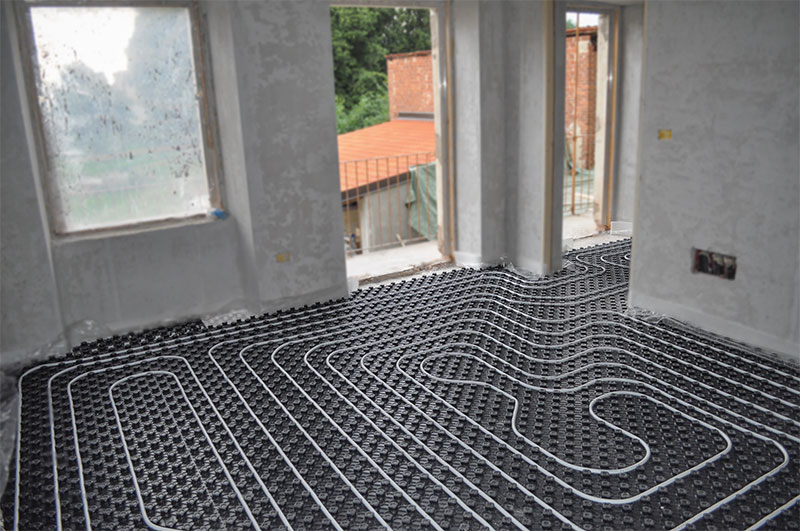Cold rooms are uncomfortable and warming them up with electric heat can be the fastest way to bring them back to a cozy level. It’s clean and affordable and there are a number of options available, including portable heaters, that can be used to add heat to a bathroom, bedroom or office space.
Some heat sources can be plugged into an existing outlet while others will need to be hard-wired to a new circuit. As you’re thinking about the best source for your electric heating needs, consider the following:
- Will this be supplemental heat or the sole heat source?
- How large is the room?
- Are there space limitations for the heater?
- Are there safety issues?
- Do you want a permanent or temporary solution?
Since there are many options, let’s take a quick look at the most common types of electric heat.

Benefits of an Electric Heating System
Each method of heating a room has its own unique set of advantages, but electric heat systems share some common features:
Low Maintenance
If the source of your heat is totally electric, then maintenance is very low, with the exception of an occasional fan failure, there are no moving parts that require upkeep.
Energy Efficient
Electric heating is 100% efficient at the point of use, meaning all the electricity that you use (and pay for) is converted directly into heat, unlike gas, wood and boiler-based systems where energy is lost through the flue. It also saves money by allowing you to control the temperature based on actual need rather than heating the whole house every time a single room gets cold.
Cost-Effective
Most electric heating systems are less expensive to purchase and install compared to other systems – such as HVAC. This is especially true when considering the long-term costs of equipment maintenance and replacement parts.
Discreet
Some of today’s electric heaters are designed to be out of sight and some are even manufactured to look like a wall hanging. Models that operate through radiation are completely silent so that they are not seen or heard.
Types of Electric Home Heating
Radiator
Electric radiators are a popular choice for folks needing temporary supplemental heat. They can be plugged into an existing outlet and operate similarly to standard hot water supplied radiators. They use thermal convection and radiant heating to heat the air around the unit and pull in the cold air below, resulting in circulation.
There are multiple fins that radiate the heat into the room. In an electric radiator, the source of the heat is diathermic oil that expands and evenly fills the outer fins. Another advantage is that the oil is slow to cool thereby acting as a type of heat storage.
The downside is that the source of the heat is localized which will create cold and hot spots within a room.
Portable Space Heater
Portable space heaters come in many shapes and sizes and represent the most-often purchased option that is available in the electric heating category. They are lightweight, can be plugged into a regular outlet, and provide quick supplemental heat for small areas. Most have thermostats that will automatically turn them off when the desired temperature is reached. They are small and able to instantly address heat needs in specific spots in a room, however, there are some serious issues to consider:
- You can’t leave them unattended if you are not home.
- They present a serious fire danger if tipped over and the safety feature doesn’t turn them off.
- At 1500 watts, many of these heaters will max out a circuit and cause the breaker to shut down the circuit.
- The heating coils are dangerous to touch and often exposed to prying fingers.
- The power cords can be a tripping hazard.
- They cannot be plugged into an extension cord.
Knowing the disadvantages, there are still some positive points:
- They are inexpensive to purchase.
- They will use less energy than an HVAC running at the same temperature.
- You can unplug it when the room warms up.
If you use it in the winter as you would a fan in the summer – only when needed – they can be an effective source of temporary heat.
Baseboard Heating
Electric baseboard heating can be purchased as a plug-in unit or permanently installed heat source. They are usually installed below windows and on the exterior walls to counteract the effect of cold walls. They operate through a heating element that quietly heats the surrounding air and through convection draws cold air in a circulation that eventually heats the room.
If the baseboard heater is a portable unit, then furniture and draperies can be avoided, since they are potential fire hazards. However, if the unit is permanently installed, it will limit furniture and drapery placement. As with other methods of spot heating, hot and cold areas will develop, so this type of heating is not the most efficient way to evenly heat a room.
Radiant Floor Heating
Electric radiant floor heating operates like other radiant heat solutions, but with a huge difference – the entire floor is heated rather than just one area. Heat wires run directly below the finished flooring material and transfer the heat to the flooring above. Instead of just heating the air and pushing it around the room, radiant heat transfers heat closer to the people and objects in the room, leaving the air temperature less affected than other methods such as HVAC. By evenly distributing the heat across the entire floor surface, radiant floor heat produces few hot or cold spots and makes the room more comfortable to be in.
In addition, radiant floor heaters typically use 12 watts per hour per square foot to heat a room which is 25% less energy required than a space heater. Couple this with a programmable thermostat and the system will automatically heat the floor at the time of day you desire, helping you to save even more money.
What is the Best Choice?
To enjoy comfortable, even heat in a room, or throughout your entire home, we recommend electric radiant heat for the following reasons:
- Easy to install – Warmup® systems can be installed by professionals or experienced DIYers. We can provide the materials, from subfloor insulation to peel and stick mats and heat cables to make sure you have everything needed in order to do a professional job.
- No maintenance required – Once installed, there is nothing else to worry about. There are no moving parts and no regular upkeep is required.
- Non-allergenic – HVAC systems are constantly moving air as they operate, which will move dust and allergens to every part of your home in the process. Radiant floor heat has no fans, and moves heat – not air.
- No noise – electric radiant floor heat is totally silent. The only thing it produces is heat.
Our electric radiant floor heating systems are the perfect solution for adding heat to an addition or remodel, but they are so energy-efficient and effective that we recommend them to heat your entire home. Warmup has been perfecting radiant floor heating for over 25 years and we stand behind our products which have the best warranties in the industry.
Contact us today for a free quote or to speak to one of our customer support representatives.







